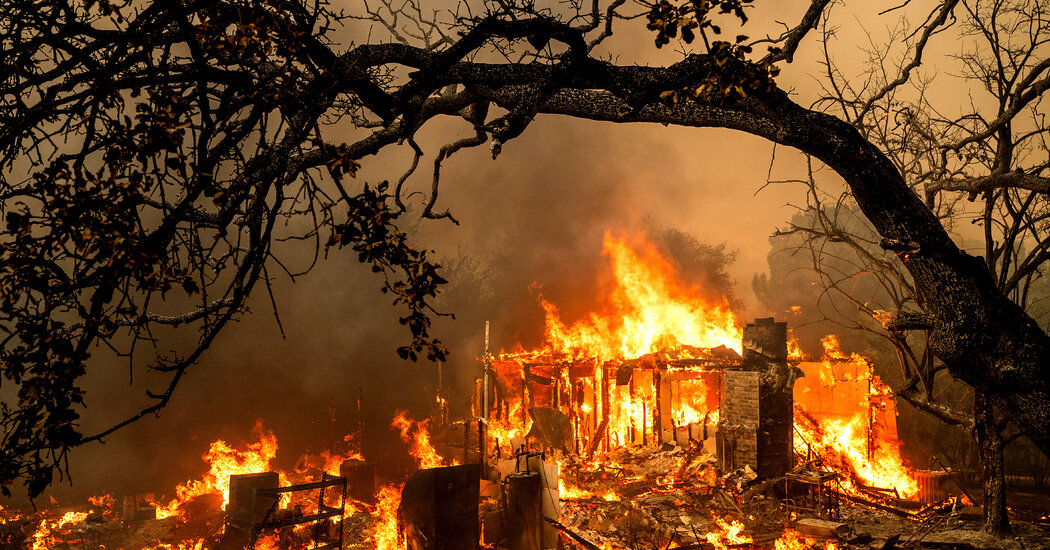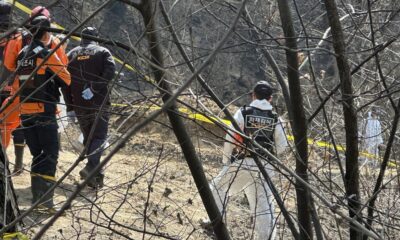Breaking News
26,000 Evacuate as Wildfire Spreads in Northern California

When a fast-moving wildfire began marching across thousands of acres of Butte County on Tuesday, David Pittman didn’t panic. He packed up his family, including their 90-pound African sulcata tortoise, and drove to his sister’s house across town in Oroville, Calif.
That’s where he’s planning to stay for the next several days — at least until firefighters get a handle on the Thompson fire, which has engulfed several homes and vehicles and has prompted about 26,000 people to evacuate, including Mr. Pittman.
“I hate to say it, but we’re experienced in this kind of stuff,” he said on Wednesday.
Mr. Pittman, 70, is the mayor of Oroville, a small Northern California town that has roots in the Gold Rush and is tucked near the state’s second-largest reservoir about 65 miles north of Sacramento. He is also a retired local fire chief who has watched his region face calamity after calamity in recent years.
In 2017, officials ordered residents to flee Oroville as thundering rapids from an emergency spillway at nearby Oroville Dam threatened to overwhelm the town. The next year, in 2018, one of the deadliest wildfires in American history, the Camp fire, killed 85 people and nearly wiped the town of Paradise — about 20 miles north of Oroville — off the map.
In 2020, a record-breaking fire season left millions of acres scorched across California, including “right into the city of Oroville,” Mr. Pittman said. In 2021, the second largest fire ever recorded in California, the Dixie fire, burned an area larger than New York, Los Angeles, Chicago and Dallas combined. It was sparked by damaged PG&E power lines near the waterway that bisects Oroville, the Feather River.
The various disasters, experts have said, are symptoms of widening climate extremes, which have plunged the West into near-constant whiplash between catastrophic floods and raging wildfires. This year, climate scientists warned that a hot summer in the West could dry out vegetation that grew abundant during a wet winter, turning what was lush green into prime tinder and making for a hazardous fire season.
For many Oroville residents at evacuation centers on Wednesday, fleeing from wildfires is becoming routine.
Sitting in the 106 degree heat outside a church shelter a few miles from the fire, Vernon Englund, 78, said this was the third time he had evacuated in four years from fires.
“We’ve been evacuated enough times that we keep to-go bags, and I just hooked up my R.V. and took off,” he said. “But I probably should have been more worried than I was, because the fire got closer than I ever thought that it would,” he added.
For Ashlie Boocks, 22, who had driven to the church shelter on Tuesday after seeing “ash the size of my palm” drifting from the sky, this was her second evacuation in three years.
On Tuesday night, she said, she drove to a spot where she could see the whole mountainside glowing with flames. “It was lit up and it was just horrible,” she said. “You’re seeing propane tanks exploding. You can hear them.”
“This is not something that should be common,” she added.
Pacific Gas & Electric, California’s biggest power utility, shut off power this week in some parts of Northern California, including Butte County, because of the increased fire risk, including nearly 2,000 homes and businesses in eight counties on Tuesday, The Sacramento Bee reported.
The Thompson fire, which erupted on Tuesday morning, remains small compared with the major fires in past years; as of Wednesday night, it had burned nearly 3,600 acres of mountainous terrain near Lake Oroville and was 7 percent contained, according to Cal Fire, the state’s firefighting agency. So far, eight injuries have been reported as a result of the blaze. And the authorities have not yet said how many structures have been damaged, though the fire has consumed homes and vehicles, based on news coverage.
Several state water facilities were affected by the evacuation orders, but there was no risk to Oroville Dam, which is the tallest dam in the United States, the California Department of Water Resources said on Tuesday night.
Mr. Pittman noted that the extreme heat baking the state this week, along with unpredictable winds, would make containing the blaze particularly difficult. Temperatures in Oroville were expected to reach 110 degrees on Wednesday and even higher toward the end of the week, according to the National Weather Service.
“We have up-and-down breezes that are pushing the fire around,” he said. “The fuels are ready to burn. So the crews have a tough job.”
He added, “I’m standing outside, and I can feel the heat through my T-shirt.”
Evacuation centers were full, he said. A large fireworks display that typically draws more than 10,000 people to Oroville was canceled to ensure that emergency workers could focus on responding to the fire.
Oroville officials on Wednesday temporarily banned the use of fireworks of any kind in the city, but stopped short of prohibiting legal sales, which local nonprofit groups have long used to raise funds in the summer. In Butte County, fireworks are illegal except in the cities of Oroville, Gridley and Biggs, where those with a “safe and sane” seal can be used.
“The last thing we need is somebody who’s purchased fireworks from a local fire stand going out and doing something stupid,” Sheriff Kory Honea of Butte County said at a news conference late Tuesday. “Don’t be an idiot, cause a fire and create more problems for us.”
Fireworks may not be as visually impressive as usual, anyway: The mayor said that the smoke in downtown Oroville was at one point so thick that he couldn’t see his hand in front of his face. Some evacuees have gathered there with trailers or recreational vehicles, but many businesses were closed.
Brian Wong said that his restaurant, Union Patio Bar and Grill, would remain open with reduced staffing because workers were dealing with their own evacuation orders. Evacuees would receive a discount, he said.
“We’ll just do what we can,” he said. “Today is about serving the community.”
But Mr. Wong, 53, said he wouldn’t be on site. Instead, he plans to stay at his home with his father-in-law, where they hope to protect the property by extinguishing any flames that get close.
Although his house is under an evacuation order and most of his neighbors have fled, Mr. Wong said that he was reluctant to do so after seeing residents of Paradise and other communities struggle to obtain insurance payments or other emergency aid.
“A lot of those cases are still not settled,” he said. “A lot of people that have properties — they’re not going to get what they were owed. So I really didn’t want to leave.”
He added that many of his neighbors had been required to pay skyrocketing insurance premiums, while others had simply gone uninsured as companies dropped coverage in many areas of California.
Mr. Wong, who has lived full-time in Oroville for more than 25 years, said that he and his family had taken precautions recommended by fire experts to clear brush on the property. He had also packed his truck full of valuables and said he was ready to leave if necessary.
Still, as of Wednesday afternoon, he was hunkering down and watching the plumes of smoke, hoping that his neighborhood would be spared.
Amanda Holpuch, Jonathan Wolfe and Yan Zhuang contributed reporting.
-

 Destination8 months ago
Destination8 months agoSingapore Airlines CEO set to join board of Air India, BA News, BA
-

 Breaking News10 months ago
Breaking News10 months agoCroatia to reintroduce compulsory military draft as regional tensions soar
-

 Tech News12 months ago
Tech News12 months agoBangladeshi police agents accused of selling citizens’ personal information on Telegram
-

 Gadgets3 months ago
Gadgets3 months agoSupernatural Season 16 Revival News, Cast, Plot and Release Date
-

 Productivity11 months ago
Productivity11 months agoHow Your Contact Center Can Become A Customer Engagement Center
-

 Gadgets3 weeks ago
Gadgets3 weeks agoFallout Season 2 Potential Release Date, Cast, Plot and News
-

 Breaking News10 months ago
Breaking News10 months agoBangladesh crisis: Refaat Ahmed sworn in as Bangladesh’s new chief justice
-

 Toys12 months ago
Toys12 months ago15 of the Best Trike & Tricycles Mums Recommend























